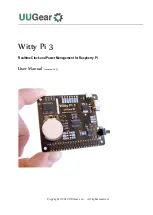
CHAPTER 9: THEORY OF OPERATION
OVERVIEW
L60 LINE PHASE COMPARISON SYSTEM – INSTRUCTION MANUAL
9-13
9
If we consider that an input to, or an output from, a logic box is a positive going signal, the logic illustrated in Figures 2A
and 2C assume that a received signal at the input of a receiver produces a positive going voltage signal at the output of
the receiver to the relay logic. This is not always true. Some types of receivers produce negative (or reference) voltage
outputs when a signal is present at the input, and a positive signal output when nothing is received. If this were the
situation, then Figure 2B represents a blocking scheme. In some applications where receiver outputs are inverted, the
interface between the receiver and the relay logic includes an inverter (INV) which in effect inverts the receiver output
signal so that a received signal produces a positive going signal at the output of the inverter. The same general statements
regarding signal polarities applies to the keying requirements for transmitters. Some transmitters can require a positive
signal while others a reference or negative signal to key them off of their quiescent states.
The main point to be gained from this discussion is that it is not always possible to determine from a logic diagram
whether a scheme is of the blocking or tripping type unless an indication is given as to the receiver output voltages. This
applies to frequency shift as well as ON-OFF communication equipment.
Subsequent discussion shows that it is extremely difficult, if not impossible, to provide a concise rigorous definition of the
terms Blocking Scheme and Tripping Scheme. First, the different kinds of channels, their characteristics, and their
application are outlined.
9.1.5.2 Channel types
A channel is composed of the communication equipment plus the path or link over which the signal is sent. For relaying
purposes, there are two types of communication equipment, as follows:
•
ON-OFF
•
Frequency-shift
The ON-OFF type operates with the transmitter being keyed on or off by the relay logic. That is, the transmitter at any given
instant is either sending an unmodulated signal or it is sending nothing.
There are two types of frequency-shift equipment. The most prevalent is the two-frequency kind. With this type, the
transmitter can send either of two closely spaced frequencies. When no keying signal is applied to the transmitter, it sends
one of these two frequencies. When the transmitter is keyed, it shifts to the other frequency. It is always sending one or the
other. The frequency-shift receiver has two separate outputs, one for each of the two transmitted signal frequencies. Thus,
if the transmitter is sending the MARK frequency, the MARK output is present in the receiver. If the transmitter is sending
the SPACE frequency, the receiver SPACE output is present. These types of receivers are basically FM receivers and utilize
discriminators. Because of this, the SPACE and MARK outputs from the receiver cannot both be present simultaneously.
Also, broad band noise at the input to the receiver tends to provide a balanced signal to the discriminator, which forces its
output towards zero. If the noise is severe enough to swamp out the real signal, it can cause random receiver output or all
output to disappear.
The other kind of frequency-shift equipment is a three-frequency type. When this type of transmitter is in its quiescent
state, it sends the center frequency. It has two separate keying inputs so that it can be keyed to shift high or low (MARK or
SPACE) from the center frequency. The three-frequency receiver receives all three frequencies but provides only two
outputs to the relay logic, the high shift and low shift outputs. When the receiver receives the center frequency neither the
high nor low outputs are present. Here again the MARK and SPACE outputs (high and low) cannot both be present
simultaneously, and severe broad band noise at the receiver inputs can result in receiver output.
There are several characteristics of communication equipment directly related to phase comparison relaying performance
that can be discussed. Phase comparison types of schemes compare the phase angle of a current derived at one end of a
line with a communication signal received from the remote end. The communication signal arrives in a MARK-SPACE
arrangement that represents the positive and negative half-cycles of current at the transmitted end of the line. Actually
this is not possible for the following reasons:
•
There is a time lag from the instant that a transmitter is keyed until the output reflects a change. This build up is
generally a very short time and is usually insignificant.
•
There is the propagation time from the instant the transmitter sends until this signal arrives at the remote location,
approximately 1 ms for every 290 km (180 miles) of distance. The same applies from the instant the transmitter stops
until the remote signal is gone.
•
There is the build up time in the receiver from the instant the signal appears at its input until the output reflects the
change of state. This time plus the build up time in the transmitter is called the channel operating time.
















































